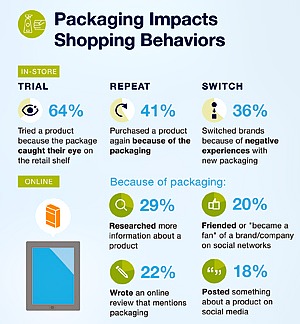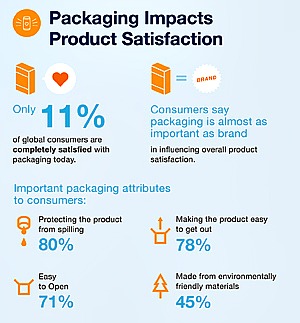
2014-06-01 00:26:47
More than Just Skin Deep
2014-06-01 00:26:47
The beauty and personal care industries have long understood the importance of packaging for drawing consumers in, creating the image of perfection and building an emotional connection at the retail shelf.
But what about the risks and opportunities for packaging beyond the shelf—on dressers, bathroom counters—and on the go?
MeadWestvaco’s (MWV) annual packaging satisfaction study, “Packaging Matters,” confirms that beauty care packaging is hugely important to consumers, but in different ways and for different reasons than brand owners have long assumed.
Now in its second year, Packaging Matters examines how packaging impacts consumer shopping behaviors and overall product satisfaction in 10 global markets, including Brazil, China, Germany, India, Japan, Russia, South Africa, Turkey, United Kingdom and the United States.
|
|
Globally, consumer purchasing behavior—trial, repeat and switch—is significantly impacted by packaging, both in-store and online. Forty-one percent of respondents surveyed about their in-store shopping habits report purchasing a product again because of the packaging, and one out of five consumers has written an online review that mentions that packaging. Packaging is important to consumer satisfaction, and consumers show an interest in sharing their experiences—negative or positive—online. This creates new opportunities for brand owners to amplify outstanding consumer product experiences and risks for widespread sharing of negative reviews.
Packaging Matters also studied which packaging attributes were most important to U.S. consumers and how they felt they were performing. While consumers still want to see a beautiful package on the retail shelf, the study revealed they also have strong feelings about how that package performs once they take it home. In fact, when it comes to overall product satisfaction, performance—attributes like “keeps the product fresh and effective,” and “protects the product from spilling or breaking”—is viewed as even more important than aesthetics.
Consumers Get the Last Word
Packaging Matters examined consumer satisfaction with packaging across 11 product categories, including beauty care and personal care. For the purposes of the study, MWV defined beauty care as facial moisturizers and cosmetics. Personal care was defined as toothpaste, shampoo, conditioner and body lotions. Globally, personal care has the second highest level of packaging satisfaction (58%) while beauty care packaging came in fourth with more than half of consumers (55%) reporting that they are completely/very satisfied.
While these categories rank among the highest satisfaction rates, gaps still exist between the importance of a packaging feature to overall product satisfaction and consumer satisfaction with the performance of that feature. For example, in the beauty category, 81% of respondents said being able to get all of the product out of the package is “extremely/very important” to their product satisfaction, but only 43% are “extremely/very satisfied” with the performance of beauty packaging for this attribute—a 38-point negative satisfaction gap. For personal care, the satisfaction gap for getting the entire product out of the package is almost the same at 35 points.
The shelf is still an important place to excel, but there, the gaps between satisfaction and performance go the other way—brand owners are “overindexed” for satisfaction with attributes like “unique shape” and “attractive appearance.” In order for brands to thrive, we need to address the negative satisfaction gaps for functional packaging performance.
Trend for Convenience
|
|
Now, let’s apply an example of this gap to facial creams. Beautiful packaging may attract a consumer’s attention on the retail shelf, but if she finds she can’t use the entire product because the last drops are stuck beyond the reach of the pump, she is unlikely to purchase that product again. Even worse, she may resort to the internet to vent her frustrations; 18% of survey respondents have posted to social media specifically about product packaging, a number we expect to continue to grow as e-commerce takes greater share of global retail. In this scenario, the brand hasn’t lost just this customer, but also friends and networks she influenced with her post.
Packaging Matters proves the importance of functional packaging attributes, even in a category known primarily for aesthetics. If brands can delight consumers in this domain, they have a better chance of encouraging repeat purchases and brand loyalty.
Another big negative satisfaction gap is “easy to reclose or reseal,” a major driver of convenience for beauty and personal care products. A consumer can’t carry her BB cream on the go if she can’t trust that it will stay closed in her purse or gym bag and easily open when she is ready to use it later in the day. Increasingly, consumers need quick and easy solutions from reliable products and don’t have patience for products that fail when they need them the most. With our busy lifestyles, brand owners can continue to expect a demand for more convenience.
Packaging can be tremendously important in influencing consumer opinion about a product. Ultimately, beauty care and personal care brand owners have to modify packaging to be both aesthetically appealing and also meet functional needs. Ignoring these asks will reflect in the decline of trial and repeat purchase and even may cause your most loyal consumers to switch brands. But embracing these demands can lead to opportunity.
The Emotional Connection to Packaging
Beauty care and personal care products are deeply emotional purchases, and the connection brands build with consumers is critical to success in the market. Solutions that look beautiful on the retail shelf also need to perform once they’re on the bathroom shelf. Aesthetics are vital to the first moment of truth, and Packaging Matters shows that features like protecting from breaking and spilling, easy to reclose and reseal and getting the entire product out of the package are much more important to building an emotional connection with consumers than appearance.
Solutions that optimize the way a product is dispensed and enhance the consumer experience positively impact perceptions of your brand. Data from the second year of the study suggests function over form is a critical component to building emotional connection with consumers.
The key takeaway: packaging is the only element of the marketing communications mix that reaches every single consumer and influences their perception throughout the life of the product. Packaging is the physical manifestation of your brand expression, and as such, it has to live up to the product inside at every single consumer touch-point. Your beauty care products are more than just skin-deep: Shouldn’t your packaging be, too?
LinkedIn






